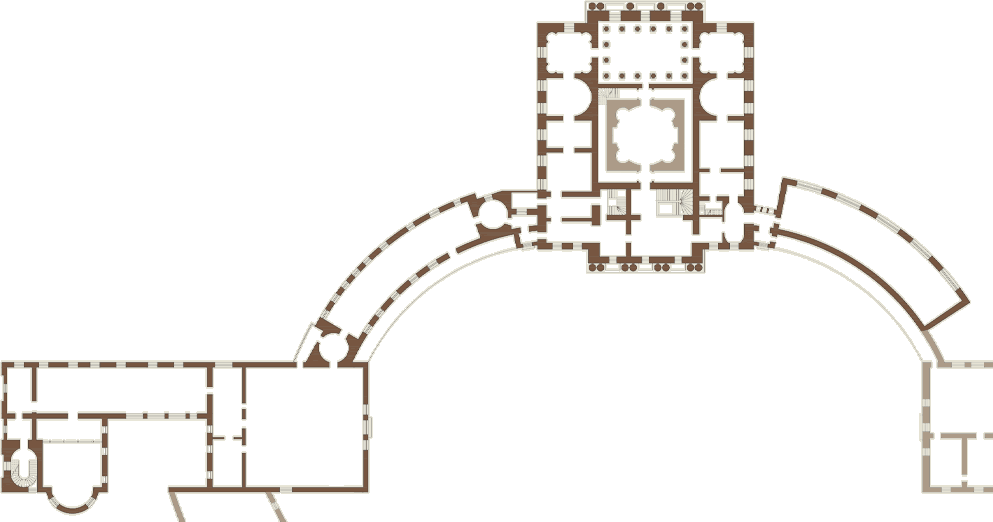The Small Study of Emperor Paul I
Загрузка панорамы...
Originally called the Study at the Library, this room was finished ca. 1790, designed by Vincenzo Brenna per the original plan of Charles Cameron. In January 1803, a fire broke out due to a spark hitting the wooden bulkhead of the fireplace, which significantly damaged the decoration of the halls of the palace and the decor. It was redecorated in 1804 per the project of Andrey Voronikhin. The study connects to the State Library of Paul I through a wide arch. Just like the Library, the walls of the Study are lined with white artificial marble, conveying the feeling of solemn severity. A low classical stucco cornice separates the walls from the ceiling, on the base of which, in the grisaille technique, fantastic griffins and female half-figures are depicted among acanthus ornaments. On the main wall of the Study, there is a portrait of the great-grandfather and idol of Paul I, Emperor Peter the Great (Germany, Antoine Pesne, the 1720s). Along the wall, there are items of furniture set of Russian work designed by Andrey Voronikhin (1804). In the foreground is a desk with a rotator clock and bronze candlesticks in the corners (France, master Pierre Denizeau, the 2nd half of the 18th century). In the right corner, there is a grandfather clock in a mahogany case decorated with Masonic emblems: an hourglass and a triangle are placed on the top cover (Germany, furniture maker David Roentgen, mechanic Peter Kinzig, the 1780s). On the mantelpiece, there is an astronomical clock Portico made of marble and gilded bronze, with an enamel dial (France, master Charpentier, the 1780s) and a set of two bronze gilded candelabra in the form of antique tripods (France, the late 18th century). There are also two vases of the Berlin Royal Manufactory (the late 18th century).
In front of the fireplace is an elegant screen of mahogany and ivory. Most of the decorations for the ivory screen were made by Empress Maria Feodorovna herself: she was fond of turning art and achieved a high level of skill in it. She also made a bone cameo with a portrait of Paul I in a bronze medallion. In the middle part of the screen, in a round bronze medallion, is a drawing on milk glass Madonna and Child by Maria Feodorovna, a copy of the original by Angelica Kauffman. A kidney table stands in front of the window, one of the earliest and unique items in the decoration of the palace (by the Russian master Matvey Veretennikov, 1787). The panorama of Pavlovsk and the early park buildings are presented in the marquetry technique. Decorative ornaments are presented on the console tables, made from ivory and amber by the Empress Maria Feodorovna together with and under the guidance of her mentor, German master of turning, Johannes (Nikolay) Fay. On both sides of the arch leading to the State Library of Paul I, there are Italian marble vases of the 18th century with reliefs based on ancient motifs brought by the owners of Pavlovsk from their trip.
The Small Study of Emperor Paul I on the floor plane
- The Egyptian Vestibule
- The Carpet Study
- The Second Interconnecting Study
- The Main Staircase
- The Hall of War
- The Picture Gallery
- The Upper Vestibule
- The Greek Hall
- The Third Interconnecting Study
- The Italian Hall
- The Hall of Peace
- The Throne Room
- The Valet de Chambre Room of Paul I
- The Library of Empress Maria Feodorovna
- The Pantry
- The Dressing Room of Paul I
- The Boudoir
- The Orchestral Room
- The Rossi Study
- The State Bedroom
- The Knights Room
- The Rossi Library
- The Dressing Room of Maria Feodorovna
- The Chevalier Guard Room
- The Small Study of Emperor Paul I
- The Maid of Honour's Room
- The Anteroom (Turkish Room)
- The State Library of Paul I
- The First Interconnecting Study
- The Palace Church

Back
